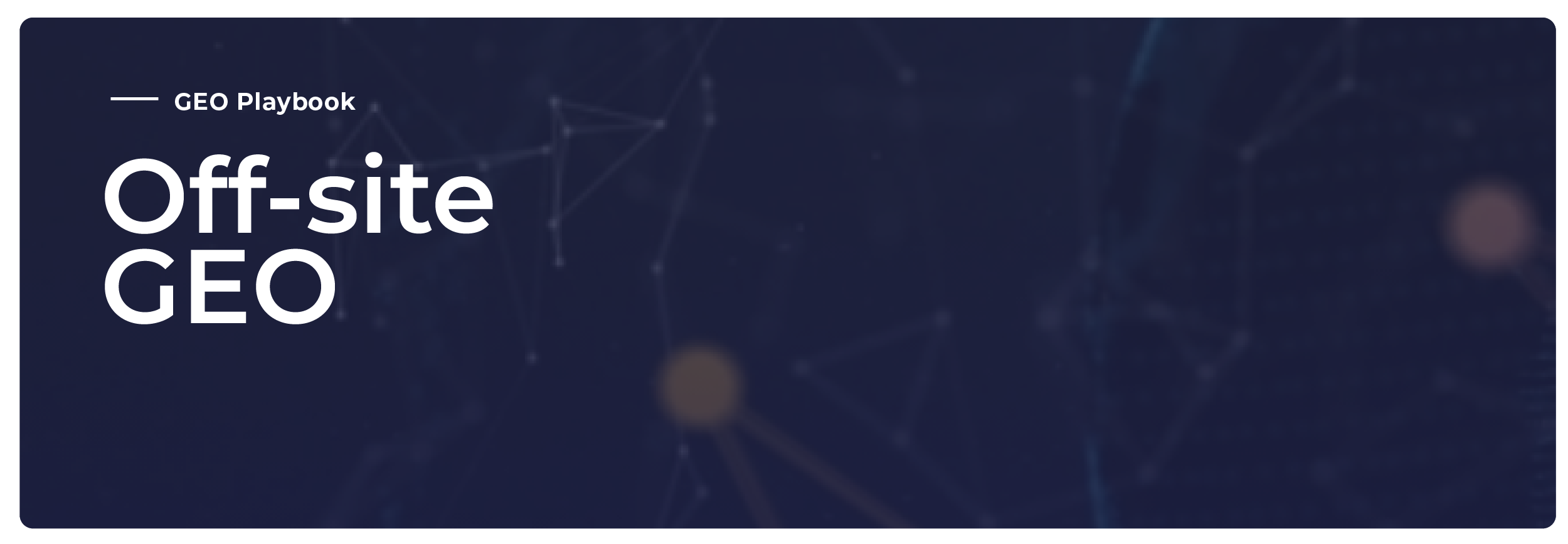_____ THE GEO PLAYBOOK
Off-site GEO: Building authority beyond your website

Off-site GEO is about how the web talks about you. Through Digital PR, data-led stories, and consistent coverage, you shape how AI systems understand your expertise and increase the chances of being cited in AI-generated answers.
It’s about creating digital footprints that go beyond backlinks, ensuring every article, quote, and dataset reinforces the expertise you want to be known for.
When your brand appears consistently across credible publications, that reputation becomes part of how large language models (LLMs) understand your business - strengthening both visibility and trust in AI-generated results.
Why off-site authority matters for GEO
Building authority for AI search requires a mix of strategy, storytelling and structure. As a GEO agency focused on AI visibility, we’ve seen how the right off-site signals can elevate a brand’s presence inside AI-generated answers.
But authority isn’t just earned through links. It’s shaped by how AI understands relationships between brands, sources, and entities. Our guide to generative AI explains how large language models build those connections and why consistent context across PR, quotes, and brand mentions reinforces them.
AI models learn from what they read - from repeated language and associations.
In practical terms, if trusted publications repeatedly describe your brand as a “UK insurance expert” or a “data-driven marketing agency”, that context is absorbed into the datasets powering AI search. These patterns tell AI systems that your brand is relevant and reliable within that field - helping it surface more often in generative results.
Off-site GEO ensures those associations happen deliberately, not by chance.
Building off-site authority takes time and coordination. If you’re considering external support for GEO or AiPR campaigns, our guide on how to choose a GEO agency outlines what to look for - from data-led storytelling to consistent context wrapping.
What is AiPR
AiPR (AI-powered PR) is Reboot’s proprietary approach to off-site GEO. It combines the creativity of Digital PR with a deep understanding of how large language models (LLMs) process information.
Unlike traditional PR, which focuses on awareness and links, AiPR plans stories for both journalists and algorithms, balancing human interest with the structured signals AI uses to assess authority.
Every story, quote, and dataset is designed to:
 Reinforce topical expertise through credible data and commentary.
Reinforce topical expertise through credible data and commentary.
 Wrap brand mentions with descriptive context (for example, “UK insurance specialists” or “digital marketing experts”).
Wrap brand mentions with descriptive context (for example, “UK insurance specialists” or “digital marketing experts”).
 Appear across authoritative domains that AI models use to assess trust and relevance.
Appear across authoritative domains that AI models use to assess trust and relevance.
Together, these elements help AI platforms connect your brand with the right topics and retrieve it more often when generating answers.
AiPR strengthens three core signals that AI uses to judge brands:
 Topical relevance - clear, repeated associations with your expertise
Topical relevance - clear, repeated associations with your expertise
 Credibility - coverage on trusted domains with transparent methodology
Credibility - coverage on trusted domains with transparent methodology
 Consistency - the same context wrapped around every mention
Consistency - the same context wrapped around every mention
Learn more about AiPR.
Learn more
What is context wrapping
Context wrapping is the process of consistently pairing your brand name with the topics and expertise you want AI to associate with you.
For example, a data study published as “Research from Alan Boswell Group, unoccupied home insurance experts” creates a strong and repeated link between the brand and its area of expertise.
When this phrasing appears across multiple trusted publications, AI models recognise it as a credible pattern and begin citing the brand for related questions.
Over time, this repetition strengthens your authority signals in both AI and traditional search.
Read our complete guide to context wrapping.
Read more
The publications AI platforms cite most
AI models rely heavily on credible, well-structured sources when generating answers. Understanding which publications are most frequently cited can help you plan campaigns that earn links and mentions where they’ll have the biggest impact on AI visibility.
According to Ahrefs, the top domains cited in AI Mode are Wikipedia, YouTube, Google’s blog, Reddit, and Google itself. Let’s break it down further.
The types of domains AI Overviews cite most
AI Overviews pull from a much broader mix of sources than traditional search. Community-led platforms such as YouTube and Reddit account for the majority of citations, reflecting users’ appetite for relatable, experience-based content. At the same time, factual hubs like Wikipedia and institutional medical sources are important for accuracy.
For marketers, this confirms the importance of blending trusted editorial placements with genuine, data-backed, and discussion-worthy content that AI can easily interpret and reuse.

| Domain type | What this means |
|---|---|
| Community and social platforms | User-generated and community-led content dominates AI citations. Models prioritise authentic experience, tutorials, and peer discussion over corporate messaging. |
| Reference and informational sources | Structured, factual, and neutral summaries remain a foundational training source for AI. |
| Corporate and technology sites | Brand-owned resources are heavily referenced for technical explanations and product data. Indicates that strong first-party documentation performs well in AI Overviews. |
| Scientific and medical sources | Evidence-based domains are frequently cited for health-related queries. Medical accuracy and transparency strengthen AI trust. |
| Ecommerce and job platforms | Transactional platforms appear when AI responses include product or employment data. Useful for brands competing in purchase-related prompts. |
| Editorial and publishing platforms | Thought leadership and original long-form analysis are cited less frequently but add diversity to AI references. |
What this means for brands
 Think beyond Domain Rating (DR)
Think beyond Domain Rating (DR)
Authority for AI isn’t just about backlinks or site metrics. AI systems value structure, clarity, and factual accuracy, favouring content that clearly explains a topic and cites reliable sources.
 Diversify your placements
Diversify your placements
Coverage in well-known editorial outlets still matters, but so do mentions in niche trade publications, forums, and community platforms. Together, these build a well-rounded trust signal that reflects how AI models learn from multiple source types.
 Context wrap every brand mention
Context wrap every brand mention
Each brand reference should link your name, area of expertise, and key topic within the same sentence or paragraph. This gives AI a clearer context about what your brand is known for - and increases the chance of being cited accurately.
 Link to trustworthy sources
Link to trustworthy sources
Incorporating links to .gov, .edu, or peer-reviewed studies strengthens your content’s credibility - as proven in our outgoing links experiment. This combination of transparency and relevance helps AI systems verify claims and reuse your information confidently.
 Measure citations
Measure citations
Track whether earned coverage actually appears inside AI-generated responses. This helps identify which publications, and which formats, are driving AI visibility.
With these patterns in mind, your AiPR strategy should focus on coverage that’s both credible to readers and recognisable to AI models.
To see how your current authority signals are being interpreted by AI, a GEO audit benchmarks your brand’s visibility and highlights where context, coverage or technical factors may be holding you back.
Book a GEO audit
Using AiPR and context wrapping in campaigns
Context wrapping works best when applied consistently across every campaign.
 Example
Example
By consistently context wrapping the brand descriptor “unoccupied home insurance experts” into every press release, subsequent coverage across BBC News, The Times, and other national outlets reinforced the association between the brand and its specialism.
Within weeks, ChatGPT and Gemini began referencing the brand by name for insurance-related queries - contributing to a 194% increase in GEO traffic and a 382% rise in ChatGPT referral visits.
This wasn’t a coincidence and was the result of deliberate context wrapping within a structured AiPR campaign.
Case study: Enhancing LLM visibility in the finance space with AiPR and context wrapping.
Case study
How to build off-site authority that AI trusts
Off-site GEO is about quality, credibility, and consistency, not quantity of links. To strengthen your brand’s authority in AI search, you must:
 Lead with data
Lead with data
Campaigns built on original datasets, FOI requests or proprietary research earn credible coverage and make it easier for AI to trust your insights.
 Demonstrate E-E-A-T
Demonstrate E-E-A-T
Include expert quotes, credentials and a clear methodology in press materials so both readers and AI can see why your content is reliable.
 Reinforce context
Reinforce context
Repeat your chosen brand descriptor (i.e. “UK [service] specialists”) across press releases, quotes, and author bios to help AI connect the dots.
 Link to hubs
Link to hubs
Direct users to your most relevant guide or service page on the same topic so authority flows back to a structured, permanent source.
 Measure impact
Measure impact
Track citations and LLM referral traffic (from ChatGPT, Bing Copilot and Perplexity) alongside link quality to see which campaigns increase AI visibility.
Read more about AI visibility tracking.
Read more
A practical framework to start
If you’re introducing AiPR for the first time, focus on these three priorities:
Month 1: Define your narrative
- Choose one core descriptor (i.e. “UK fintech consultancy experts”).
- Review existing coverage to see if this descriptor is used consistently.
- Update boilerplates, press kits, and LinkedIn profiles to reinforce it.
Month 2: Run data-driven AiPR campaigns
- Create a story supported by proprietary or first-party data.
- Add expert commentary from your team to reinforce E-E-A-T signals.
- Context wrap your brand mentions in all press materials and quotes.
Month 3: Track and refine
- Monitor brand mentions and AI citations across ChatGPT, Gemini and Perplexity.
- Segment LLM referral traffic in GA4 to track uplift.
- Evaluate which topics and phrasing perform best, and refine future PR plans accordingly.
This process turns PR coverage into structured, AI-readable authority.
Where next?
Discover examples of GEO in action, where we show how these campaigns translate into real results. Or head back to the previous page on off-site GEO.
Back to the GEO playbook homepage


